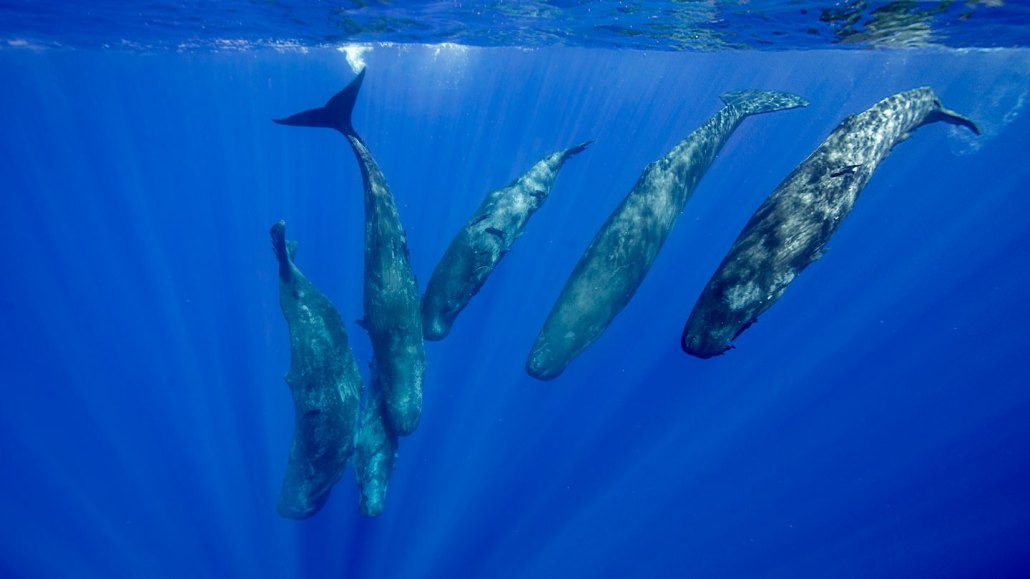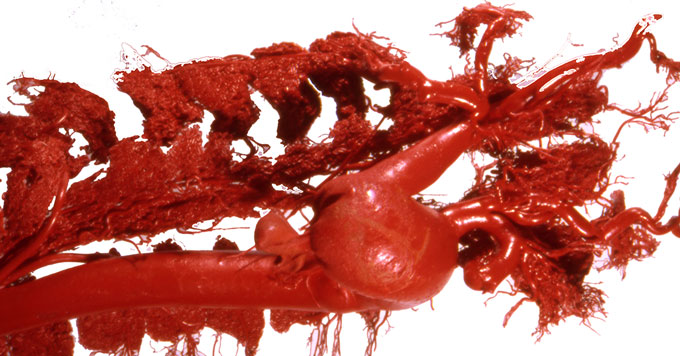
Sperm whales (shown) dive far underwater looking for food. Dense, intricate networks of blood vessels allow the animals to accomplish the feat without harming their brains.
by wildestanimal/Moment/Getty Images Plus
- More than 2 years ago
If you look at parts of the circulatory system of whales and dolphins, you might think that you are looking at a Jackson Pollock painting, not blood vessels. These cetaceans have especially dense, complex networks of blood vessels mainly associated with the brain and spine, but scientists didn’t know why. A new analysis suggests that the networks protect cetaceans’ brains from the pulses of blood pressure that the animals endure while diving deep in the ocean, researchers report in the Sept. 23 Science.
Whales and dolphins “have gone through these really amazing vascular adaptations to support their brain,” says Ashley Blawas, a marine scientist at the Duke University Marine Lab in Beaufort, N.C., who was not involved with the research.
Called retia mirabilia, which means “wonderful nets,” the blood vessel networks are present in some other animals besides cetaceans, including giraffes and horses. But the networks aren’t found in other aquatic vertebrates that move differently from whales, such as seals. So scientists had suspected that the cetaceans’ retia mirabilia play a role in controlling blood pressure surges.
When whales and dolphins dive, they move their tail up and down in an undulating manner, which creates surges in blood pressure. Land animals that experience similar surges, like galloping horses, are able to release some of this pressure by exhaling. But some cetaceans hold their breath to dive for long periods of time (SN: 9/23/20). Without a way to relieve that pressure, those blasts could tear blood vessels and harm other organs, including the brain.
In the new study, biomechanics researcher Margo Lillie of the University of British Columbia in Vancouver and colleagues used data on the morphology of 11 cetacean species to create a computational model that can simulate the animals’ retia mirabilia. It revealed that the arteries and veins in this tangle of blood vessels are really close and may even sometimes be joined. As a result, the retia mirabilia could equalize the differences in blood pressure generated by diving, perhaps by redistributing the blood pulses from arteries to veins and vice versa. This way, the networks get rid of, or at least weaken, huge blood pressure surges that might otherwise reach and devastate the brain.

The networks “equalize the [blood flow] in a way that you never lose that blood that’s in the vein and it doesn’t collapse down on itself, and you don’t have that shooting arterial blood going really fast into the brain,” says marine biologist Tiffany Keenan of the University of North Carolina Wilmington who was not involved in the study. “It’s really neat to know what we’ve always wondered, but no one had been able to show.”
Still, studying cetaceans is tricky due to their protected status and limited access to samples, which are usually from animals that have been stranded, researchers say. For this reason, one limitation of the new study is that the researchers had to input data from different species to make their model.
“They take a little bit from here and a little bit from there, mixing a dolphin with a beluga whale with a beaked whale — it is sort of like a quilt,” says Andreas Fahlman, a marine scientist at the Oceanogràfic Foundation in Valencia, Spain, who was not involved in the study.
As a result, the model may be missing important aspects that might be specific to other species, which have unique anatomies and even move differently, with some staying closer to the surface or others diving deeper. Taking a closer look at the circulatory system of whales and dolphins, perhaps using nonintrusive techniques such sensors that can measure blood flow and pressure, may help confirm that the computational model reflects real-life dynamics.






